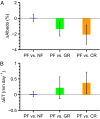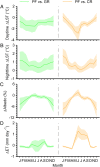Afforestation in China cools local land surface temperature
- PMID: 24516135
- PMCID: PMC3939881
- DOI: 10.1073/pnas.1315126111
Afforestation in China cools local land surface temperature
Abstract
China has the largest afforested area in the world (∼62 million hectares in 2008), and these forests are carbon sinks. The climatic effect of these new forests depends on how radiant and turbulent energy fluxes over these plantations modify surface temperature. For instance, a lower albedo may cause warming, which negates the climatic benefits of carbon sequestration. Here, we used satellite measurements of land surface temperature (LST) from planted forests and adjacent grasslands or croplands in China to understand how afforestation affects LST. Afforestation is found to decrease daytime LST by about 1.1 ± 0.5 °C (mean ± 1 SD) and to increase nighttime LST by about 0.2 ± 0.5 °C, on average. The observed daytime cooling is a result of increased evapotranspiration. The nighttime warming is found to increase with latitude and decrease with average rainfall. Afforestation in dry regions therefore leads to net warming, as daytime cooling is offset by nighttime warming. Thus, it is necessary to carefully consider where to plant trees to realize potential climatic benefits in future afforestation projects.
Keywords: climate change mitigation; plantation effects; surface cooling; vegetation feedback.
Conflict of interest statement
The authors declare no conflict of interest.
Figures




References
-
- Food and Agriculture Organization of the United Nations (2010) Global Forest Resources Assessment 2010. Food and Agriculture Organization of the United Nations. Available at: http://www.fao.org/forestry/fra/fra2010/en/. Accessed February 7, 2012.
-
- State Forestry Administration of the People's Republic of China . Seventh National Forest Resource Inventory Report (2004-2008) Beijing: State Forestry Administration of the People's Republic of China; 2009.
-
- Fang JY, Chen AP, Peng CH, Zhao SQ, Ci L. Changes in forest biomass carbon storage in China between 1949 and 1998. Science. 2001;292(5525):2320–2322. - PubMed
-
- Piao SL, et al. The carbon balance of terrestrial ecosystems in China. Nature. 2009;458(7241):1009–1013. - PubMed
Publication types
MeSH terms
LinkOut - more resources
Full Text Sources
Other Literature Sources
Medical
Molecular Biology Databases

